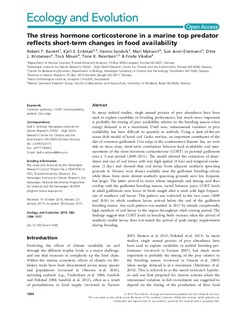| dc.contributor.author | Barrett, Robert T. | |
| dc.contributor.author | Erikstad, Kjell E. | |
| dc.contributor.author | Sandvik, Hanno | |
| dc.contributor.author | Myksvoll, Mari Skuggedal | |
| dc.contributor.author | Jenni-Eiermann, Susi | |
| dc.contributor.author | Kristensen, Ditte Lyngbo | |
| dc.contributor.author | Moum, Truls | |
| dc.contributor.author | Reiertsen, Tone K. | |
| dc.contributor.author | Vikebø, Frode Bendiksen | |
| dc.date.accessioned | 2015-06-26T13:20:44Z | |
| dc.date.accessioned | 2015-06-29T09:03:49Z | |
| dc.date.available | 2015-06-26T13:20:44Z | |
| dc.date.available | 2015-06-29T09:03:49Z | |
| dc.date.issued | 2015 | |
| dc.identifier.citation | Barrett, R.T., Erikstad, K.E., Sandvik, H., Myksvoll, M.S., Jenni-Eiermann, S., Kristensen, D.L., ... Vikebø, F.B. (2015). The stress hormone corticosterone in a marine top predator reflects short-term changes in food availability. Ecology and Evolution, 5(6), 1306-1317. doi: | nb_NO |
| dc.identifier.issn | 2045-7758 | |
| dc.identifier.uri | http://hdl.handle.net/11250/285914 | |
| dc.description.abstract | In many seabird studies, single annual proxies of prey abundance have been used to explain variability in breeding performance, but much more important is probably the timing of prey availability relative to the breeding season when energy demand is at a maximum. Until now, intraseasonal variation in prey availability has been difficult to quantify in seabirds. Using a state-of-the-art ocean drift model of larval cod Gadus morhua, an important constituent of the diet of common guillemots Uria aalge in the southwestern Barents Sea, we were able to show clear, short-term correlations between food availability and measurements of the stress hormone corticosterone (CORT) in parental guillemots over a 3-year period (2009–2011). The model allowed the extraction of abundance and size of cod larvae with very high spatial (4 km) and temporal resolutions (1 day) and showed that cod larvae from adjacent northern spawning grounds in Norway were always available near the guillemot breeding colony while those from more distant southerly spawning grounds were less frequent, but larger. The latter arrived in waves whose magnitude and timing, and thus overlap with the guillemot breeding season, varied between years. CORT levels in adult guillemots were lower in birds caught after a week with high frequencies of southern cod larvae. This pattern was restricted to the two years (2009 and 2010) in which southern larvae arrived before the end of the guillemot breeding season. Any such pattern was masked in 2011 by already exceptionally high numbers of cod larvae in the region throughout chick-rearing period. The findings suggest that CORT levels in breeding birds increase when the arrival of southern sizable larvae does not match the period of peak energy requirements during breeding. | nb_NO |
| dc.language.iso | eng | nb_NO |
| dc.publisher | Wiley | nb_NO |
| dc.rights | Navngivelse 3.0 Norge | * |
| dc.rights.uri | http://creativecommons.org/licenses/by/3.0/no/ | * |
| dc.title | The stress hormone corticosterone in a marine top predator reflects short-term changes in food availability | nb_NO |
| dc.type | Journal article | nb_NO |
| dc.type | Peer reviewed | nb_NO |
| dc.date.updated | 2015-06-26T13:20:44Z | |
| dc.rights.holder | © 2015, The Author(s) | |
| dc.subject.nsi | VDP::Mathematics and natural science: 400::Zoology and botany: 480 | nb_NO |
| dc.source.pagenumber | 1306-1317 | nb_NO |
| dc.source.volume | 5 | nb_NO |
| dc.source.journal | Ecology and Evolution | nb_NO |
| dc.source.issue | 6 | nb_NO |
| dc.identifier.doi | 10.1002/ece3.1438 | |
| dc.identifier.cristin | 1229608 | |
| dc.relation.project | Norges forskningsråd: 216547 | nb_NO |

